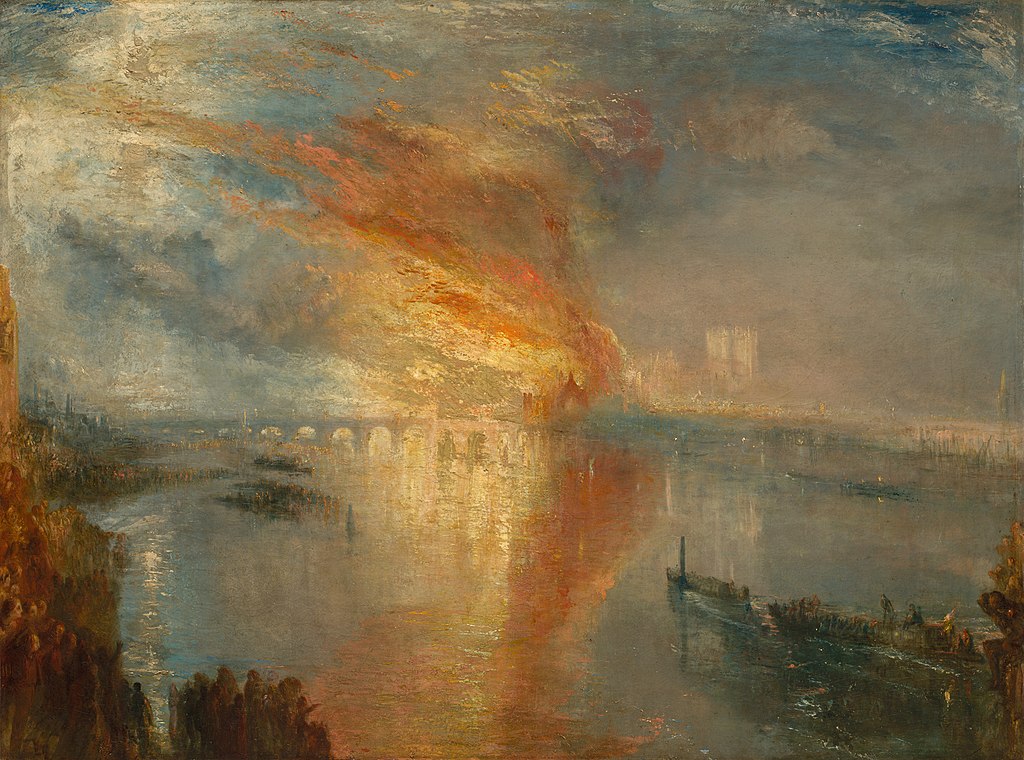|
Where? Gallery 251 of the Museum of Fine Arts in Boston
When? 1840 What do you see? Vibrant colors and bright light make for what appears to be a beautiful sunset over the sea. However, upon further inspection, the scene is actually a dark one. The foreground is littered with the bodies of drowning slaves. Their chained arms reach out of the water to try to survive. And on the bottom right, we can see a single leg sticking out of the water. The slaves are not going to survive as a school of fish are already biting away at their flesh, and some birds are arriving to get their share as well. Behind the drowning slaves, a ship is caught in a storm, waves crashing against its sides as it steers away from the slaves. Backstory: This painting is also known as Slavers Throwing Overboard the Dead and the Dying – Typhon Coming On. Turner based The Slave Ship off of a true story to illustrate the realities of the slave trade. In 1781, Luke Collingwood, the English captain of the slave ship Zong, set sail with 470 slaves and an inadequate amount of food and water. When crew members and slaves began to fall ill, Collingwood threw 132 slaves overboard to save his ship. He would also receive insurance money for the slaves “lost at sea.” Turner painted the aftermath of this terrible act and adds a touch of justice by sending the ship into a violent storm in the background. English Abolitionism: Following the Zong Massacre in 1781, Granville Sharp, a leading abolitionist, made an attempt to charge Collingwood with murder. However, because slaves were considered commodities like wood and tea, the captain was ruled innocent. While this may seem like a failure, the Massacre actually raised awareness of the anti-slavery movement and inspired more Englishmen to join the cause. Eventually, slavery was abolished in England in 1833. Who is Turner? Joseph Mallord William Turner was born in 1775 in London where he died in 1851. He was an English romantic painter who attended the Royal Academy of Arts in London and studied with Thomas Malton. His early works were topographical watercolor paintings and engravings that appeared in books and magazines. In hopes of achieving something greater, Turner completed his first oil painting, Fishermen at Sea, which was displayed at the Royal Academy in 1796. The work received high praise and got him elected as an associate of the Royal Academy. Around this time, Turner made many copies of the works of landscape painter John Robert Cozens. Cozens’s more imaginative style encouraged Turner to experiment with a more whimsical and romantic style that eventually brought him to fame. Turner’s landscapes show a mastery of many different terrains and expertise in color and light that feels somewhat like that of the impressionists of the later 19th century. Among his famous works are his two version of The Burning of the Houses of Lords and Commons. One version is in the Philadelphia Museum of Art and the other in the Cleveland Museum of Art.
Fun fact: When Slave Ship was first displayed at the Royal Academy, it was accompanied by an excerpt of a poem that Turner wrote. The long poem, “Fallacies of Hope,” was never finished and published. Here is the excerpt:
“Aloft all hands, strike the top-masts and belay;
Yon angry setting sun and fierce-edged clouds Declare the Typhon’s coming. Before it sweeps your decks, throw overboard The dead and dying - ne’er heed their chains Hope, Hope, fallacious Hope! Where is thy market now?”
0 Comments
|
Categories
All
|
- Home
- Blog
-
Museums
- Alte Pinakothek
- Art Institute of Chicago
- Baltimore Museum of Art
- Barber Institute of Fine Arts
- Bargello
- Barnes Foundation
- British Museum
- Church of Sant’Anastasia
- Cleveland Museum of Art
- Courtauld Institute of Art
- Detroit Institute of Arts
- Frans Hals Museum
- Galleria Borghese
- Gallerie dell'Accademia
- Getty Museum
- Guggenheim
- Hermitage Museum
- Kunsthistorisches Museum
- Kunstmuseum Basel
- Legion of Honor Museum
- Louvre
- Mauritshuis
- Metropolitan Museum of Art
- Musee d’Orsay
- Museum of Fine Arts in Boston
- Museum of Modern Art
- National Gallery in London
- National Gallery of Art
- National Museum in Poznań
- Norton Simon Museum
- Ny Carlsberg Glyptotek
- Palace of Versailles
- Palazzo Pitti
- Palazzo Vecchio
- Petit Palais
- Philadelphia Museum of Art
- Prado
- Pushkin Museum
- Ravenna Art Museum
- Rijksmuseum
- San Diego Museum of Art
- Santa Maria delle Grazie
- St. Peter's Basilica
- Städel Museum
- Statens Museum for Kunst
- Tate Britain
- Tate Modern
- Timken Museum of Art
- Uffizi
- Vatican Museums
- Wallace Collection
-
Artists
- Altdorfer
- Anguissola
- Berlin Painter
- Bosch
- Botticelli
- Boucher
- Bronzino
- Bruegel the Elder
- Brunelleschi
- Cabanel
- Caillebotte
- Canova
- Caravaggio
- Carpeaux
- Cezanne
- Cimabue
- David
- Degas
- Delacroix
- De Maria
- Donatello
- El Greco
- Fontana
- Fra Angelico
- Fragonard
- Gauguin
- Gentileschi
- Gericault
- Gonzalez-Torres
- Goya
- Hals
- Hogarth
- Hokusai
- Ingres
- Leonardo da Vinci
- Lippi, Filippo
- Longhi, Barbara
- Lorrain
- Makovsky
- Manet
- Massys
- Matisse
- Merian
- Michelangelo
- Mochi
- Modigliani
- Monet
- Panini
- Parmigianino
- Perugino
- Picasso
- Pisanello
- Raphael
- Rembrandt
- Renoir
- Reynolds
- Rivera
- Rodin
- Rubens
- Scultori
- Seurat
- Steen
- Tintoretto
- Titian
- Toulouse-Lautrec
- Turner
- Uccello
- Van der Weyden
- Van Dyck
- Van Eyck
- Van Gogh
- Van Hemessen
- Vasari
- Velazquez
- Vermeer
- Veronese
- Vigée Le Brun
-
Locations
- Books
- About Us



